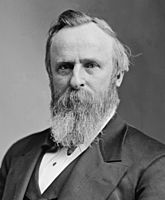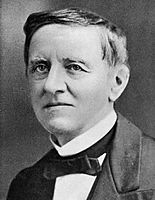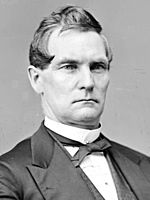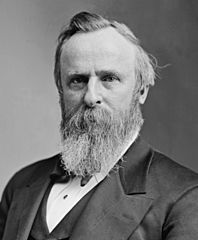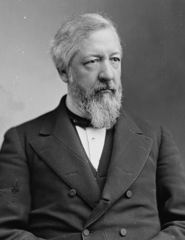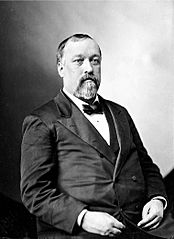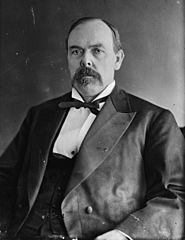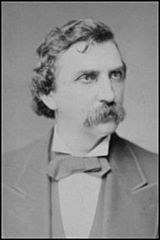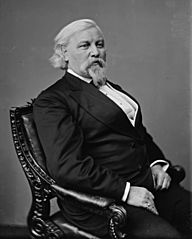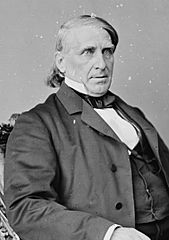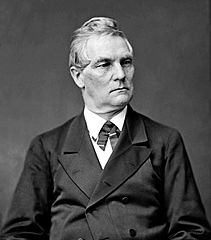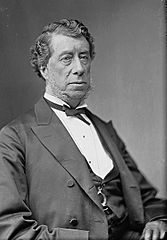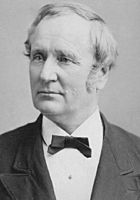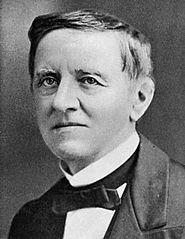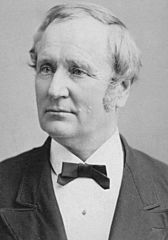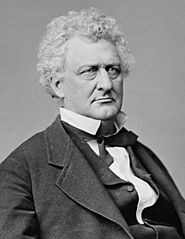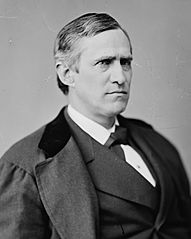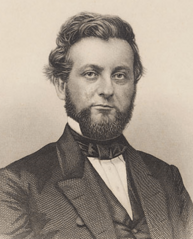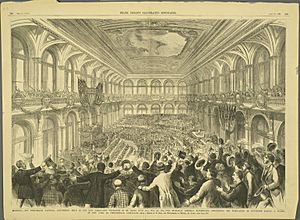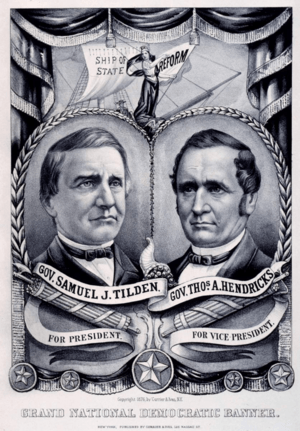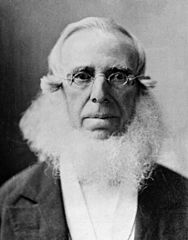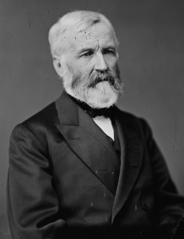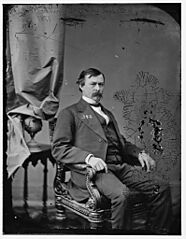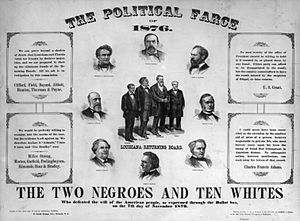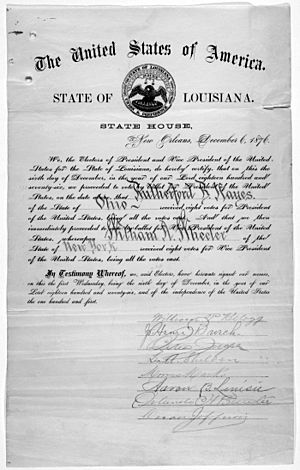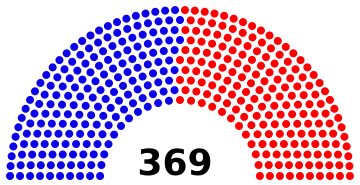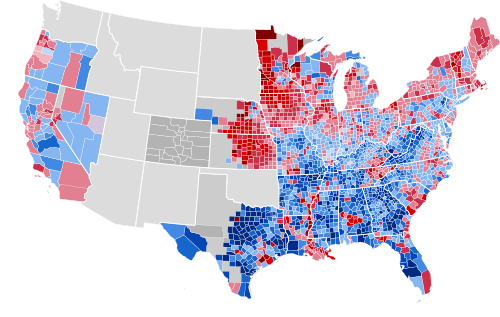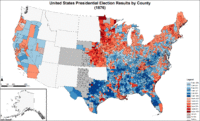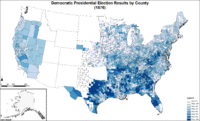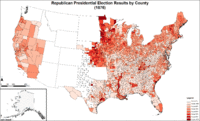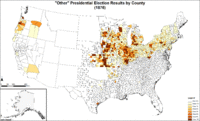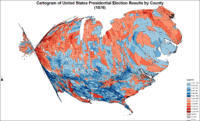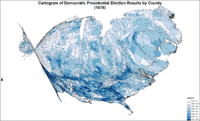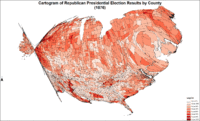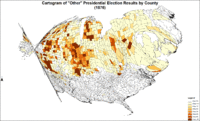1876 United States presidential election facts for kids
|
|||||||||||||||||||||||||||||
|
369 members of the Electoral College 185 electoral votes needed to win |
|||||||||||||||||||||||||||||
|---|---|---|---|---|---|---|---|---|---|---|---|---|---|---|---|---|---|---|---|---|---|---|---|---|---|---|---|---|---|
| Turnout | 81.8% |
||||||||||||||||||||||||||||
|
|||||||||||||||||||||||||||||
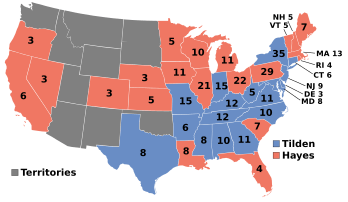 Presidential election results map. Red denotes states won by Hayes/Wheeler, blue denotes those won by Tilden/Hendricks. Numbers indicate the number of electoral votes allotted to each state.
|
|||||||||||||||||||||||||||||
|
|||||||||||||||||||||||||||||
The 1876 United States presidential election was the 23rd presidential election in American history. It happened on Tuesday, November 7, 1876. In this election, the Republican candidate, Rutherford B. Hayes, ran against the Democratic candidate, Samuel J. Tilden.
This election was one of the most debated and difficult in American history. It was decided through special talks and agreements between the two main parties. It was also the second time in U.S. history that the person who won the election did not win the most individual votes from people across the country.
After President Ulysses S. Grant decided not to run for a third term, James G. Blaine was a top choice for the Republicans. However, he didn't get enough votes at the Republican meeting. So, they chose Governor Hayes from Ohio as a compromise. The Democrats chose Governor Tilden from New York.
The election results were very close and caused a lot of arguments. Tilden clearly won more individual votes than Hayes. But there were many claims of cheating and violence during the election. Some voters, especially Black Republicans, were stopped from voting.
After the first count, Tilden had 184 electoral votes and Hayes had 165. But 20 votes from four states were still undecided. In Florida, Louisiana, and South Carolina, both parties said their candidate had won. In Oregon, one elector was replaced because he held another government job. Deciding who should get these 20 votes caused a big problem.
To solve this, an informal agreement was made. This agreement is known as the Compromise of 1877. The Democrats agreed to give all 20 disputed electoral votes to Hayes. In return, the Republicans promised to remove federal troops from the Southern states. This action officially ended the period known as Reconstruction.
This election still holds records. It had the smallest difference in electoral votes (185 for Hayes to 184 for Tilden). It also had the highest number of eligible voters participate in American history, with 81.8% turning out.
Even though he didn't become president, Tilden was the first Democratic candidate since 1856 to win the popular vote. He was also the first since 1852 to win it with a clear majority. This election is also the only one where both major party candidates were sitting governors.
Contents
Choosing Candidates: How Parties Picked Their Leaders
Republican Party: Choosing Rutherford B. Hayes
| 1876 Republican Party ticket | |||||||||||||||||||||||||||||
| Rutherford B. Hayes | William A. Wheeler | ||||||||||||||||||||||||||||
|---|---|---|---|---|---|---|---|---|---|---|---|---|---|---|---|---|---|---|---|---|---|---|---|---|---|---|---|---|---|
| for President | for Vice President | ||||||||||||||||||||||||||||
| 29th & 32nd Governor of Ohio (1868–1872 & 1876–1877) |
U.S. Representative for New York's 19th (1861–1863 & 1869–1877) |
||||||||||||||||||||||||||||
-
Senator James G. Blaine from Maine
-
Senator Oliver P. Morton from Indiana
-
Senator Roscoe Conkling from New York
-
Postmaster General Marshall Jewell
-
Representative
William A. Wheeler from New York -
Secretary of State
Hamilton Fish from New York
(declined to run) -
President Ulysses S. Grant
(declined in 1875)
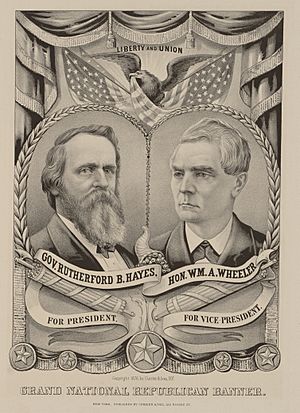
In 1875, many people thought President Ulysses S. Grant would try for a third term. But there were economic problems and political scandals during his time in office. Also, there was a long-standing tradition, started by George Washington, that presidents only serve two terms.
On December 15, 1875, the House of Representatives voted that the two-term tradition was important to prevent a dictatorship. After this, Grant decided not to run in 1876. He even tried to convince his Secretary of State, Hamilton Fish, to run, but Fish felt he was too old.
The Republican National Convention met in Cincinnati, Ohio, on June 14, 1876. At first, James G. Blaine seemed like the most likely choice for president. But many Republicans worried that Blaine might not win the main election. So, his support started to drop.
The delegates who didn't want Blaine couldn't agree on another candidate for a while. Then, they chose Ohio Governor Rutherford B. Hayes. Hayes had been slowly gaining support. On the seventh vote, Hayes was chosen as the presidential candidate. He received 384 votes.
For vice president, William A. Wheeler, a Representative from New York, was nominated easily. He won with 366 votes. His main opponent, Frederick T. Frelinghuysen, later helped decide the election results.
| Presidential Ballot | |||||||||||||||||||||||
| Ballot | 1st | 2nd | 3rd | 4th | 5th | 6th | 7th | ||||||||||||||||
|---|---|---|---|---|---|---|---|---|---|---|---|---|---|---|---|---|---|---|---|---|---|---|---|
| James G. Blaine | 285 | 296 | 293 | 292 | 286 | 308 | 351 | ||||||||||||||||
| Oliver P. Morton | 124 | 120 | 113 | 108 | 95 | 85 | 0 | ||||||||||||||||
| Benjamin Bristow | 113 | 114 | 121 | 126 | 114 | 111 | 21 | ||||||||||||||||
| Roscoe Conkling | 99 | 93 | 90 | 84 | 82 | 81 | 0 | ||||||||||||||||
| Rutherford B. Hayes | 61 | 64 | 67 | 68 | 104 | 113 | 384 | ||||||||||||||||
| John F. Hartranft | 58 | 63 | 68 | 71 | 69 | 50 | 0 | ||||||||||||||||
| Marshall Jewell | 11 | 0 | 0 | 0 | 0 | 0 | 0 | ||||||||||||||||
| William A. Wheeler | 3 | 3 | 2 | 2 | 2 | 2 | 0 | ||||||||||||||||
| Elihu B. Washburne | 0 | 1 | 1 | 3 | 3 | 4 | 0 | ||||||||||||||||
| Vice Presidential Ballot | |||||||||||||||||||||||
| Ballot | 1st Partial | ||||||||||||||||||||||
|---|---|---|---|---|---|---|---|---|---|---|---|---|---|---|---|---|---|---|---|---|---|---|---|
| William A. Wheeler | 366 | ||||||||||||||||||||||
| Frederick T. Frelinghuysen | 89 | ||||||||||||||||||||||
| Marshall Jewell | 86 | ||||||||||||||||||||||
| Stewart L. Woodford | 70 | ||||||||||||||||||||||
| Joseph R. Hawley | 25 | ||||||||||||||||||||||
Democratic Party: Choosing Samuel J. Tilden
| 1876 Democratic Party ticket | |||||||||||||||||||||||||||||
| Samuel J. Tilden | Thomas A. Hendricks | ||||||||||||||||||||||||||||
|---|---|---|---|---|---|---|---|---|---|---|---|---|---|---|---|---|---|---|---|---|---|---|---|---|---|---|---|---|---|
| for President | for Vice President | ||||||||||||||||||||||||||||
| 25th Governor of New York (1875–1876) |
16th Governor of Indiana (1873–1877) |
||||||||||||||||||||||||||||
| Campaign | |||||||||||||||||||||||||||||
Democratic candidates who wanted to be president included:
- Samuel J. Tilden, governor of New York
- Thomas A. Hendricks, governor of Indiana
- Winfield Scott Hancock, a major general from Pennsylvania
- William Allen, former governor of Ohio
- Thomas F. Bayard, U.S. senator from Delaware
- Joel Parker, former governor of New Jersey
-
William Allen from Ohio
-
Joel Parker from New Jersey
The Democratic National Convention met in St. Louis, Missouri, in June 1876. This was the first major political convention held west of the Mississippi River. About 5,000 people filled the hall, hoping for the Democratic Party's first presidential win in 20 years.
The party's main ideas called for big changes. They wanted to fix the problems and scandals that happened during the Grant administration. Tilden won more than 400 votes on the first ballot. He then won the presidential nomination by a large amount on the second ballot.
Tilden won against several other candidates. These included Thomas A. Hendricks, Winfield Scott Hancock, and William Allen. He also overcame strong opposition from "Honest John" Kelly, a powerful New York political leader. Thomas A. Hendricks was chosen as the vice presidential candidate. He was the only person put forward for that position.
The Democratic Party promised to replace corruption with honest government. They also wanted to end the "carpetbag tyrannies" in the South. They also supported protecting U.S. citizens visiting their home countries. Other goals included limiting Asian immigration and changing tariffs. Many Democrats were very excited about Tilden's nomination.
| Presidential Ballot | ||||||
| 1st Before Shifts | 1st After Shifts | 2nd Before Shifts | 2nd After Shifts | Unanimous | ||
|---|---|---|---|---|---|---|
| Samuel J. Tilden | 400.5 | 416.5 | 535 | 517 | 738 | |
| Thomas A. Hendricks | 139.5 | 139.5 | 85 | 87 | ||
| Winfield Scott Hancock | 75 | 75 | 58 | 58 | ||
| William Allen | 54 | 54 | 54 | 54 | ||
| Thomas F. Bayard | 33 | 33 | 4 | 4 | ||
| Joel Parker | 18 | 18 | 0 | 18 | ||
| James Broadhead | 16 | 0 | 0 | 0 | ||
| Allen G. Thurman | 2 | 2 | 2 | 0 | ||
| Vice Presidential Ballot | |
| 1st | |
|---|---|
| Thomas A. Hendricks | 730 |
| Blank | 8 |
Other Parties: Greenback and Prohibition Candidates
The Greenback Party was formed by farmers in 1874. They wanted the government to print more paper money, called "greenbacks." This would help the economy. Their first national meeting was in Indianapolis in 1876.
They nominated Peter Cooper for president. He received 352 votes. They also chose Newton Booth for vice president. But Booth decided not to run. So, the party picked Samuel Fenton Cary instead.
The Prohibition Party held its second national meeting in Cleveland. They nominated Green Clay Smith for president. Gideon T. Stewart was chosen as his vice presidential candidate. This party wanted to stop the sale of alcoholic drinks.
The American National Party was a smaller group. They had different names in different states. They met in Pittsburgh, Pennsylvania, in 1875. They supported changes to the Constitution from the Reconstruction era. They also wanted international agreements and reading the Bible in public schools.
This party also wanted to end the Electoral College. They were against secret societies and monopolies. They chose James B. Walker for president. Donald Kirkpatrick was nominated for vice president.
Candidates gallery
-
Andrew Curtin from Pennsylvania
-
William Allen from Ohio
-
Alexander Campbell from Illinois
The Main Election Campaign
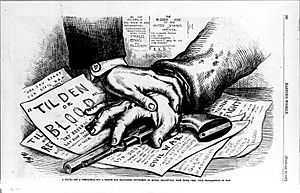
Tilden had a reputation for fighting corruption in New York. He had even helped put a famous political boss, William M. Tweed, in jail. So, he ran as a candidate who would bring reform. This was important because of the scandals during the Grant administration.
Both parties wanted to improve government and end Reconstruction. The campaigns were full of negative attacks. Democrats criticized Republicans for corruption. Republicans brought up the Civil War, which Democrats called "waving the bloody shirt." Republicans would say, "Not every Democrat was a rebel, but every rebel was a Democrat."
Hayes was not very well known outside of Ohio. He had been a representative and governor there. One person called him "a third-rate nonentity." But Hayes had fought bravely in the Civil War. He was wounded several times and was a major-general. His military service made him popular with veterans. He also helped the Republican Party win Ohio, which was a very important state.
A newspaper writer described Tilden as a "fidgety old bachelor." He said Tilden didn't have much emotion.
In the South, Democrats used groups like the Red Shirts and the White League. These groups tried to stop Black and White Republican voters. They would break up meetings and use violence. They saw themselves as the military part of the Democratic Party.
Back then, it was not considered proper for candidates to actively campaign. So, Tilden and Hayes did not travel around giving speeches. Other people campaigned for them.
Colorado's Unique Electoral Votes
Colorado became the 38th state on August 1, 1876. There wasn't enough time or money to hold a presidential election there. So, Colorado's state legislature chose the state's three Electoral College electors.
The legislature voted, and Hayes's electors received 50 votes. Tilden's electors only got 24 votes. Many of the legislative races in October 1876 were decided by only a few hundred votes. Colorado's electors gave all three of their votes to Hayes. This was the last time any state chose its electors this way. Usually, electors are chosen by popular vote.
The Disputed Election and the Compromise of 1877
The election results were very close in Florida (4 electoral votes), Louisiana (8), and South Carolina (7). These states reported that Tilden had won. But there were many reports of cheating and threats against Republican voters. In South Carolina, it was even reported that 101% of eligible voters had cast ballots. About 150 Black Republicans were reportedly killed.
One problem was how ballots looked. At that time, parties printed their own ballots. To help voters who couldn't read, parties put symbols on the ballots. In this election, many Democratic ballots had the Republican symbol of Abraham Lincoln on them. The election boards in these states, which were mostly Republican, rejected enough Democratic votes to give their electoral votes to Hayes.
In two Southern states, the Republican certificates were signed by the governor recognized by the U.S. government. The Democratic certificates from Florida were signed by the state attorney-general and the new Democratic governor. Those from Louisiana were signed by the Democratic candidate for governor. The South Carolina Democratic certificates were not signed by any state official.
In Oregon, there was a dispute over one elector's vote. Hayes clearly won the state. But Oregon's Democratic governor, La Fayette Grover, said one Republican elector, John Watts, couldn't serve. This was because Watts had been a postmaster, which was a federal job. The Constitution says electors cannot hold a federal office.
Governor Grover replaced Watts with a Democratic elector. But the two other Republican electors ignored Grover's action. They reported three votes for Hayes. The Democratic elector, C. A. Cronin, reported one vote for Tilden and two for Hayes.
In the end, all three of Oregon's votes went to Hayes. This gave Hayes a majority of just one vote in the Electoral College. Democrats claimed there was fraud. People across the country were very tense. Some even threatened that Hayes would not become president. A shot was fired at Hayes's home in Ohio. President Grant quietly increased military presence around Washington D.C.
The Constitution says the President of the Senate should open and count the electoral certificates. Republicans believed the President of the Senate had the power to count the votes. This would mean the Republican President Pro Tempore of the Senate, Thomas W. Ferry, could count the disputed votes for Hayes.
Democrats disagreed. They said that Congress should continue the practice of needing both the House and Senate to agree on any vote that was questioned. Since the House had a Democratic majority, rejecting even one state's vote would make Tilden president.
To solve this big problem, Congress passed a law on January 29, 1877. This law created a 15-member Electoral Commission. This commission would decide the election. Five members were chosen from each house of Congress. Five members were also chosen from the U.S. Supreme Court.
The majority party in each house chose three members. The minority party chose two. This meant there were five Democratic and five Republican members on the commission. Of the Supreme Court justices, two Republicans and two Democrats were chosen. These four justices then chose a fifth justice.
The justices first chose Justice David Davis. No one was sure which candidate Davis preferred. But just as the law was being passed, the Illinois Legislature chose Davis to be a Senator. Democrats in the legislature thought this would make Davis support them. However, they were wrong. Davis stepped down from the commission and resigned as a Justice to take his Senate seat. All the remaining available justices were Republicans. So, they chose Joseph P. Bradley, who was thought to be the most fair remaining judge. This choice was very important.

Note that Ripon - the commonly recognized birthplace of the Republican Party - is in Fond du Lac County, Wisconsin which voted for Tilden.
The commission met on January 31, as Inauguration Day was getting close. Each disputed state's election (Florida, Louisiana, Oregon, and South Carolina) was presented to the commission. Lawyers for each side argued their cases. Each state had two sets of election results.
The commission decided not to question any results that seemed legal at first glance. Then, Justice Bradley joined the seven other Republican members. They voted 8–7 to give all 20 disputed electoral votes to Hayes. This gave Hayes a 185–184 electoral vote victory. The commission finished its work on March 2.
Hayes secretly took the oath of office the next day. He was publicly sworn into office on March 5, 1877, without any problems.
During private meetings, Democratic leaders agreed to accept Hayes as president. In return, federal troops were removed from the last two Southern states they occupied: South Carolina and Louisiana. Republican leaders also agreed to some benefits. These included federal money for a transcontinental railroad line through the South. Some of these promises were not kept, like the railroad. But it was enough to prevent a dangerous situation.
The results accepted by the commission showed Hayes won South Carolina by only 889 votes. This was the second-closest popular vote difference in a deciding state in U.S. history. The closest was the election of 2000, decided by 537 votes in Florida. In 2000, George W. Bush won the Electoral College by five votes. Hayes won by just one.
After his defeat, Tilden said he could leave public life knowing that people would remember him as being elected to the highest office. He said he would have the credit without the worries of the job.
Later, in 1887, Congress passed the Electoral Count Act. This law created more detailed rules for counting electoral votes. It especially helped in cases where a state sent in more than one set of electors.
Election Results: Who Won Where?
The commission's decisions showed that Tilden won in 1,301 counties (57.85%). Hayes won in 947 counties (42.11%). One county in Nevada had an equal number of votes for Tilden and Hayes.
The Greenback Party did not win the election. They received less than one percent of the total votes. But their candidate, Cooper, had the best performance for a third-party candidate since John Bell in 1860. The Greenbacks did best in Kansas, where Cooper got over six percent of the vote. In Indiana, he received 17,207 votes. This was much more than Tilden's winning margin of about 5,500 votes over Hayes in that state.
The 1876 election was the last one before the end of the Reconstruction era. This period aimed to protect the rights of African Americans in the South. These voters usually supported Republican candidates.
After 1876, no former slave state would vote Republican again until 1896. That year, William McKinley won Delaware, Maryland, West Virginia, and Kentucky. No Republican presidential candidate would win any states that had left the Union and joined the Confederacy until Warren G. Harding in 1920. He won Tennessee, which had been "reconstructed" earlier.
None of the Southern states that had federal troops for a long time voted Republican again until Herbert Hoover in 1928. He won Texas, Florida, North Carolina, and Virginia. This was also the last time a Republican won Louisiana until 1956. And it was the last time a Republican won South Carolina until 1964.
The next time those two states voted against Democrats was when they supported the "Dixiecrat" candidate Strom Thurmond in 1948.
The 1876 election was the last time the South had a close two-party election. After this, Democrats controlled the South until 1948. It was also the last time Democrats won certain counties in North Carolina, Tennessee, and Kentucky. Hayes was the only Republican president elected who did not win Indiana.
| Presidential candidate | Party | Home state | Popular vote | Electoral vote |
Running mate | |||
|---|---|---|---|---|---|---|---|---|
| Count | Percentage | Vice-presidential candidate | Home state | Electoral vote | ||||
| Rutherford Birchard Hayes | Republican | Ohio | 4,034,142 | 47.92% | 185 | William Almon Wheeler | New York | 185 |
| Samuel Jones Tilden | Democratic | New York | 4,286,808 | 50.92% | 184 | Thomas Andrews Hendricks | Indiana | 184 |
| Peter Cooper | Greenback | New York | 83,726 | 0.99% | 0 | Samuel Fenton Cary | Ohio | 0 |
| Green Clay Smith | Prohibition | Washington, D.C. | 6,945 | 0.08% | 0 | Gideon Tabor Stewart | Ohio | 0 |
| James Walker | American National Party | Illinois | 463 | 0.01% | 0 | Donald Kirkpatrick | New York | 0 |
| Other | 6,575 | 0.08% | — | Other | — | |||
| Total | 8,418,659 | 100% | 369 | 369 | ||||
| Needed to win | 185 | 185 | ||||||
| Popular vote | ||||
|---|---|---|---|---|
| Tilden | 50.92% | |||
| Hayes | 47.92% | |||
| Cooper | 0.99% | |||
| Others | 0.17% | |||
| Electoral vote | ||||
|---|---|---|---|---|
| Hayes | 50.14% | |||
| Tilden | 49.86% | |||
Map of Election Results
More Maps of the Election
-
Cartogram of presidential election results by county
State-by-State Election Results
Source: Data from Walter Dean Burnham, Presidential ballots, 1836–1892 (Johns Hopkins University Press, 1955) pp 247–57.
| States/districts won by Tilden/Hendricks |
| States/districts won by Hayes/Wheeler |
| Samuel J. Tilden Democratic |
Rutherford B. Hayes Republican |
Peter Cooper Greenback |
Green Smith Prohibition |
Margin | State Total | |||||||||||||
|---|---|---|---|---|---|---|---|---|---|---|---|---|---|---|---|---|---|---|
| State | electoral votes |
# | % | electoral votes |
# | % | electoral votes |
# | % | electoral votes |
# | % | electoral votes |
# | % | total votes cast |
% | |
| Alabama | 10 | 102,989 | 59.98 | 10 | 68,708 | 40.02 | – | – | – | – | – | – | – | −34,281 | −19.97 | 171,699 | 2.04% | AL |
| Arkansas | 6 | 58,086 | 59.92 | 6 | 38,649 | 39.87 | – | 211 | 0.22 | – | – | – | – | −19,437 | −20.05 | 96,946 | 1.15% | AR |
| California | 6 | 76,460 | 49.08 | – | 79,258 | 50.88 | 6 | 47 | 0.03 | – | – | – | – | 2,798 | 1.80 | 155,784 | 1.85% | CA |
| Colorado* | 3 | – | – | – | – | – | 3 | – | – | – | – | – | – | – | – | – | - | CO |
| Connecticut | 6 | 61,927 | 50.70 | 6 | 59,033 | 48.33 | – | 774 | 0.63 | – | 374 | 0.31 | – | −2,894 | −2.37 | 122,134 | 1.45% | CT |
| Delaware | 3 | 13,381 | 55.45 | 3 | 10,752 | 44.55 | – | – | – | – | – | – | – | −2,629 | −10.89 | 24,133 | 0.29% | DE |
| Florida | 4 | 22,927 | 49.01 | – | 23,849 | 50.99 | 4 | – | – | – | – | – | – | 922 | 1.97 | 46,776 | 0.56% | FL |
| Georgia | 11 | 130,157 | 72.03 | 11 | 50,533 | 27.97 | – | – | – | – | – | – | – | −79,624 | −44.07 | 180,690 | 2.15% | GA |
| Illinois | 21 | 258,611 | 46.66 | – | 278,232 | 50.20 | 21 | 17,207 | 3.10 | – | – | – | – | 19,621 | 3.54 | 554,227 | 6.58% | IL |
| Indiana | 15 | 213,526 | 48.65 | 15 | 208,011 | 47.39 | – | 17,233 | 3.93 | – | 141 | 0.03 | – | −5,515 | −1.26 | 438,911 | 5.21% | IN |
| Iowa | 11 | 112,121 | 38.28 | – | 171,326 | 58.50 | 11 | 9,431 | 3.22 | – | – | – | – | 59,205 | 20.21 | 292,878 | 3.48% | IA |
| Kansas | 5 | 37,902 | 30.53 | – | 78,324 | 63.10 | 5 | 7,770 | 6.26 | – | 110 | 0.09 | – | 40,422 | 32.56 | 124,134 | 1.47% | KS |
| Kentucky | 12 | 160,060 | 61.41 | 12 | 97,568 | 37.44 | – | – | – | – | – | – | – | −62,492 | −23.98 | 260,626 | 3.10% | KY |
| Louisiana | 8 | 70,508 | 48.35 | – | 75,315 | 51.65 | 8 | – | – | – | – | – | – | 4,807 | 3.30 | 145,823 | 1.73% | LA |
| Maine | 7 | 49,917 | 42.65 | – | 66,300 | 56.64 | 7 | – | – | – | – | – | – | 16,383 | 14.00 | 117,045 | 1.39% | ME |
| Maryland | 8 | 91,779 | 56.05 | 8 | 71,980 | 43.95 | – | – | – | – | – | – | – | −19,799 | −12.09 | 163,759 | 1.95% | MD |
| Massachusetts | 13 | 108,777 | 41.90 | – | 150,064 | 57.80 | 13 | – | – | – | – | – | – | 41,287 | 15.90 | 259,620 | 3.08% | MA |
| Michigan | 11 | 141,685 | 44.49 | – | 166,901 | 52.41 | 11 | 9,023 | 2.83 | – | 766 | 0.24 | – | 25,216 | 7.92 | 318,450 | 3.78% | MI |
| Minnesota | 5 | 48,587 | 39.16 | – | 72,955 | 58.80 | 5 | 2,389 | 1.93 | – | 144 | 0.12 | – | 24,368 | 19.64 | 124,075 | 1.47% | MN |
| Mississippi | 8 | 112,173 | 68.08 | 8 | 52,603 | 31.92 | – | – | – | – | – | – | – | −59,570 | −36.15 | 164,776 | 1.96% | MS |
| Missouri | 15 | 202,086 | 57.64 | 15 | 145,027 | 41.36 | – | 3,497 | 1.00 | – | – | – | – | −57,059 | −16.27 | 350,610 | 4.16% | MO |
| Nebraska | 3 | 17,413 | 35.30 | – | 31,915 | 64.70 | 3 | – | – | – | – | – | – | 14,502 | 29.40 | 49,328 | 0.59% | NE |
| Nevada | 3 | 9,308 | 47.27 | – | 10,383 | 52.73 | 3 | – | – | – | – | – | – | 1,075 | 5.46 | 19,691 | 0.23% | NV |
| New Hampshire | 5 | 38,510 | 48.05 | – | 41,540 | 51.83 | 5 | – | – | – | – | – | – | 3,030 | 3.78 | 80,141 | 0.95% | NH |
| New Jersey | 9 | 115,962 | 52.66 | 9 | 103,517 | 47.01 | – | 714 | 0.32 | – | – | – | – | −12,445 | −5.65 | 220,193 | 2.62% | NJ |
| New York | 35 | 521,949 | 51.40 | 35 | 489,207 | 48.17 | – | 1,978 | 0.19 | – | 2,369 | 0.23 | – | −32,742 | −3.22 | 1,015,503 | 12.06% | NY |
| North Carolina | 10 | 125,427 | 53.62 | 10 | 108,484 | 46.38 | – | – | – | – | – | – | – | −16,943 | −7.24 | 233,911 | 2.78% | NC |
| Ohio | 22 | 323,182 | 49.07 | – | 330,698 | 50.21 | 22 | 3,057 | 0.46 | – | 1,636 | 0.25 | – | 7,516 | 1.14 | 658,649 | 7.82% | OH |
| Oregon | 3 | 14,157 | 47.38 | – | 15,214 | 50.92 | 3 | 510 | 1.71 | – | – | – | – | 1,057 | 3.54 | 29,881 | 0.35% | OR |
| Pennsylvania | 29 | 366,204 | 48.25 | – | 384,184 | 50.62 | 29 | 7,204 | 0.95 | – | 1,318 | 0.17 | – | 17,980 | 2.37 | 758,993 | 9.02% | PA |
| Rhode Island | 4 | 10,712 | 40.23 | – | 15,787 | 59.29 | 4 | 68 | 0.26 | – | 60 | 0.23 | – | 5,075 | 19.06 | 26,627 | 0.32% | RI |
| South Carolina | 7 | 90,897 | 49.76 | – | 91,786 | 50.24 | 7 | – | – | – | – | – | – | 889 | 0.49 | 182,683 | 2.17% | SC |
| Tennessee | 12 | 133,177 | 59.79 | 12 | 89,566 | 40.21 | – | – | – | – | – | – | – | −43,611 | −19.58 | 222,743 | 2.65% | TN |
| Texas | 8 | 104,755 | 70.04 | 8 | 44,800 | 29.96 | – | – | – | – | – | – | – | −59,955 | −40.09 | 149,555 | 1.78% | TX |
| Vermont | 5 | 20,254 | 31.38 | – | 44,091 | 68.30 | 5 | – | – | – | – | – | – | 23,837 | 36.93 | 64,553 | 0.77% | VT |
| Virginia | 11 | 140,770 | 59.58 | 11 | 95,518 | 40.42 | – | – | – | – | – | – | – | −45,252 | −19.15 | 236,288 | 2.81% | VA |
| West Virginia | 5 | 56,546 | 56.75 | 5 | 41,997 | 42.15 | – | 1,104 | 1.11 | – | – | – | – | −14,549 | −14.60 | 99,647 | 1.18% | WV |
| Wisconsin | 10 | 123,926 | 48.19 | – | 130,067 | 50.57 | 10 | 1,509 | 0.59 | – | 27 | 0.01 | – | 6,141 | 2.39 | 257,177 | 3.05% | WI |
| TOTALS: | 369 | 4,286,808 | 50.92 | 184 | 4,034,142 | 47.92 | 185 | 83,726 | 0.99 | – | 6,945 | 0.08 | – | -252,666 | -3.00 | 8,418,659 | 100% | US |
States with Very Close Results
These states had a winning margin of less than 1% (7 electoral votes):
- South Carolina, 0.49% (889 votes) (This state was key to the final result)
These states had a winning margin between 1% and 5% (164 electoral votes):
- Ohio, 1.14% (7,516 votes)
- Indiana, 1.26% (5,515 votes)
- California, 1.80% (2,798 votes)
- Florida, 1.97% (922 votes)
- Pennsylvania, 2.37% (17,980 votes)
- Connecticut, 2.37% (2,894 votes)
- Wisconsin, 2.39% (6,141 votes)
- New York, 3.22% (32,742 votes)
- Louisiana, 3.30% (4,807 votes)
- Oregon, 3.54% (1,057 votes)
- Illinois, 3.54% (19,621 votes)
- New Hampshire, 3.78% (3,030 votes)
These states had a winning margin between 5% and 10% (33 electoral votes):
- Nevada, 5.46% (1,075 votes)
- New Jersey, 5.65% (12,445 votes)
- North Carolina, 7.24% (16,943 votes)
- Michigan, 7.92% (25,216 votes)
See also
 In Spanish: Elecciones presidenciales de Estados Unidos de 1876 para niños
In Spanish: Elecciones presidenciales de Estados Unidos de 1876 para niños


